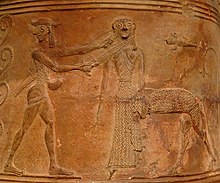Talaria

The Talaria of Mercury(Latin:tālāria) orThe Winged Sandals of Hermes(Ancient Greek:πτηνοπέδῑλος,ptēnopédilosorπτερόεντα πέδιλα,pteróenta pédila) are wingedsandals,a symbol of the Greek messenger godHermes(RomanequivalentMercury). They were said to be made by the godHephaestusof imperishable gold and they flew the god as swift as any bird.[citation needed]
Etymology
[edit]The Latin nountālāria,neuter plural oftālārissignifies "of theankle".It is not quite certain how the Romans arrived at the meaning of" winged sandals "from this, possibly that the wings were attached at the ankles, or the sandals were tied around the ankles.[1]
Attestations
[edit]
In ancient Greek literature, the sandals of Hermes are first of all mentioned byHomer(ἀμβρόσια χρύσεια;ambrósia khrýseia,"immortal/divine and of gold" ), though not described as "winged".[3][1][4]
The description of the sandals being winged first appear in the poemShield of Heracles(c. 600 – 550 BC), which speaks ofπτερόεντα πέδιλα(pteróenta pédila), literally "winged sandals".[1][5]TheHomeric hymnto Hermes from a somewhat later date (520 BC) does not explicitly state the sandals were winged, though they allowed him to leave nofootprintswhile committing his theft of Apollo's cattle.[4]
According to one estimation, it was around 5th century BC when the winged sandals came to be regarded as common (though not indispensable) accoutrements of the god Hermes.[1]One later instance which refers to the sandals being winged is theOrphic HymnsXXVIII to Hermes (3rd century BC to 2nd century AD).[6][4]
Perseuswears Hermes' sandals to help him slayMedusa.[7]According toAeschylus,Hermes gives them to him directly.[8]In a better-attested version, Perseus must retrieve them from theGraeae,along with thecap of invisibilityand thekibisis(sack).[9]
Latin sources
[edit]The termtalariahas been employed byOvidin the 1st century, and prior to him, in perhaps eight instances by various Latin authors (Cicero, Virgil, etc.).[10]The term is usually construed as "winged sandals", and applied almost exclusively to the footwear worn by the god Hermes/Mercury or the hero Perseus.[11]
Medieval interpretation
[edit]In the case of thetalariaworn by the swift runnerAtalanta(Ovid,MetamorphosesX.591) some translators in the past steered away from recognizing them as footwear, and chose to regard them as "long robes, reaching to the ankle",starting withPlanudesin the 14th century. This interpretation was also endorsed in the 17th century byNicolaas Heinsius's gloss, and persisted in the 19th century withLewis and Short's dictionary entry for this particular passage.[12]But there are "insuperable" reasons against this "robes" interpretation, for Ovid clearly states in the foregoing passages that Atalanta had disrobed[a]to engage in the foot-race.[13][b]
Also in the medieval Irish versions of theAeneid(Imtheachta Aeniasa) and theDestruction of Troy(Togail Troí), Mercury wears a "bird covering" or "feather mantle" (Old Irish:encennach, énchendach), which clearly derives from Mercury'stalaria,such as described byVirgil.[14][15][c]

Sometimes, it has been interpreted that Hermes feet are winged, rather that the wings being part of his sandals.[16]
In popular culture
[edit]InRick Riordan'sPercy Jackson & the Olympiansseries, the talaria is a pair of sneakers worn byGrover Underwood.[17]
InGod of War III,Kratosforcibly takes the Boots of Hermes off the Messenger God's feet by cutting his legs off.[18]
InTerraria,the player can acquire the item Hermes' Boots, which increase the players movement speed.[19]
The American companyGoodyear Tire and Rubber Companyhas a logo of the winged sandals of Mercury, Hermes’ Roman form.[20]
The Brazilian football (soccer) teamPaysandu Sport Clubhave a talarium in the logo.
The Pegasus Boots fromThe Legend of Zelda: Link's Awakeningare based on the talaria.
See also
[edit]- EADS Talarionan unmanned air vehicle named after talaria.
- Hermes also wears a wingedpetasos,a traveler hat. In other representations he wears awinged helmet.
- Caduceus,the staff of Hermes
Explanatory notes
[edit]- ^Latin:positovelamine
- ^However, the reading Atalanta as racing naked (as Anderson insists) is rejected in favor of a more "modest interpretation" by certain translators (F. Bernini 1943, T. Morino 1946), who perceive Atalanta as still clothed (intalaraia), which were seen to have "moved" (Italian:mossa) or were "tossed aside" (Italian:gettata viaby her fast-moving feet.[13]
- ^Whitley Stokes (1881) pointed to the parallel to thefjaðrhamr(feather cloak) of Old Norse texts.[14]
References
[edit]- Citations
- ^abcdAnderson (1966),p. 8.
- ^Gantz, 541.
- ^Homer, Odyssey, V, 44.
- ^abcFreedman (2014–2015),pp. 190–191.
- ^Hesiod,Shield of Heracles,220.
- ^Orphic Hymn 28, v. 4
- ^Gaius Julius Hyginus,Fables(LXIV) andNonnus,Dionysiaca,(XIV, 270).
- ^Aeschylus,The Phorkides,fr. 262 iv, v Radt.
- ^Pherecydes,3F11Fragmente der griechischen Historiker,and theBibliotheca (Pseudo-Apollodorus),II, 4, 2.
- ^Anderson (1966),p. 7.
- ^Anderson (1966),p. 5.
- ^Anderson (1966),pp. 1–2.
- ^abAnderson (1966),pp. 2–3.
- ^abMiles, Brent (2011).Heroic Saga and Classical Epic in Medieval Ireland.Cambridge: DS Brewer. pp. 75–76.ISBN1843842645.ISSN0261-9865.
{{cite book}}:|work=ignored (help) - ^eDIL, s.v. "énchendach"."bird-covering, feather mantle.. [but] in the following exx. the meaning seems transferred, wings, feathers; a winged thing.. rogab [Mercuir] a enceandaigh uime...┐ gabaid a luirg n-encheandaighi ina laim (i.e., the talaria and caduceus), Aen.[Imtheachta Aeniasa] 766–7.. encennach Mercúir, cumma imthéit muir ┐ tír, LL 220 b26 = TTr. [Togail Troi] 258. "
- ^Wasson, Donald L (2018-11-06)."Mercury (Deity)".World History Encyclopedia.Retrieved30 October2020.
[...] his winged feet giving him the advantage of speed, and so was the patron of circulation in general - of people, goods and messages.
- ^Riordan, Rick (July 1, 2005).The Lightning Thief.United States Of America:Puffin BooksDisney-Hyperion.ISBN0-7868-5629-7.
- ^"God of War: Every Greek God Kratos Meets In The Series".IGN.
- ^"Terraria: How to Defend Against a Goblin Army".Screen Rant.
- ^"Goodyear Corporate: The Origin of the Wingedfoot".
- Bibliography
- Anderson, William S. (1966). "Talaria and Ovid Met. 10.591".Transactions and Proceedings of the American Philological Association.97:1–13.doi:10.2307/2935997.JSTOR2935997.
- Freedman, Luba (2014–2015),"'Argicida Mercurius' from Homer to Giraldi and from Greek Vases to Sansovino ",Memoirs of the American Academy in Rome 2014/2015,vol. 59/60, University of Michigan Press for the American Academy in Rome, pp. 181–254,JSTOR44981977
- Gantz, Timothy(2004).Mythes de la Grèce archaïque,Berlin. pp. 541–543.
External links
[edit] Media related toTalariaat Wikimedia Commons
Media related toTalariaat Wikimedia Commons
